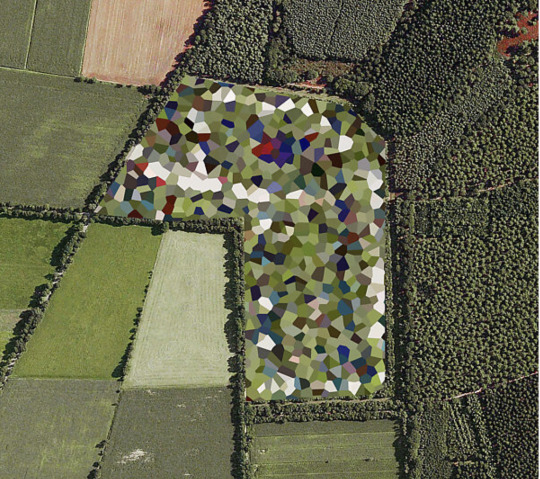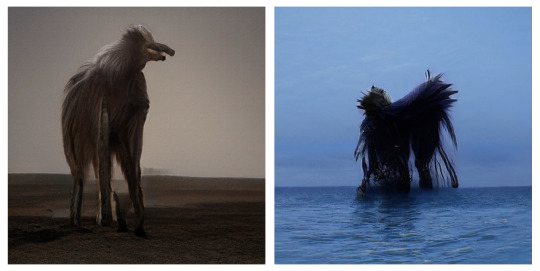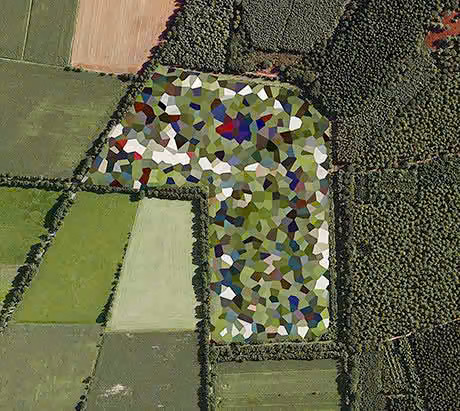#Mishka Henner
Explore tagged Tumblr posts
Text

Staphorst Ammunition Depot, Overijssel, 2011
Mishka Henner
137 notes
·
View notes
Text


Mishka Henner, The Fertile Image, 2020. Parent Set #7, Archival pigment prints on Baryta paper, 30.5x38.1 cm
0 notes
Text

Cedar Point Oil Field, Harris County, Texas Mishka Henner (b.1976) University of Salford
2 notes
·
View notes
Text

[ARTIST REVIEW] MISHKA HENNER
Mishka Henner is a Belgian-born contemporary artist, known for his innovative approach to digital media and photography. Henner’s work often explores themes of surveillance, the role of technology in shaping contemporary life, and the reimagining of traditional artistic forms through digital manipulation. His practice often involves the use of found images, internet archives, and GPS technologies, recontextualizing these resources to question the nature of representation and authorship in the digital age. Henner's works invite viewers to reconsider the relationship between image-making and the evolving digital landscape, particularly how images can be altered, appropriated, and reinterpreted in an era dominated by online platforms and satellite technology. I chose Mishka Henner for his series Dutch Landscapes because of the way he transforms traditional notions of landscape photography. In this series, Henner uses satellite images to present aerial views of the Netherlands, showcasing the country’s planned and engineered landscape. These images, as unconventional as it gets, highlight the power of technology in shaping and controlling our understanding of the land. Henner’s work challenges the viewer to rethink the relationship between the natural world and human intervention, drawing attention to how technology can reshape our visual language and perception of the environment.
0 notes
Text
Artist Review 2
Artist Review 2
Read the article (The Rise of Glitch ArtLinks to an external site.) and pick one work by one of the artist.
Find and post images, links, video or other information about the artist.
Create a short bio about the artist.
Choose one work to describe in detail and explain why you picked it. (Use your own words. If you chose to include text from an article you should make it clear what text this is and note your sources.)
Ensure you post written response for both to receive full credit. thinking about the their creative approach to making, themes and ideas they investigate with their images.
The image I chose for this discussion attached below, is From the Dutch Landscapes series by Mishka Henner. Mishka HennerLinks to an external site. uses Google Earth to capture images of the Dutch countryside, revealing a modern, almost abstract view of the landscape. Henner is well-known for his work that frequently explores themes of monitoring, digital culture, and the intersection between the real and the virtual. This series of Henner's images is non-traditional in that it does not involve actual fieldwork or personal interaction with the environment around him. Instead, they are created through the internet, emphasizing ways in which data and technology affect how we see the world. This strategy highlights the way that landscape photography is moving from everyday life to online environments.
Contemporary photographer Mishka Henner was born in Manchester, England, in 1976. Mishka frequently generates and manipulates his imagery using digital tools and online platforms. He is known for integrating technological advances and internet platforms in his photographs. His art examines topics of technology, monitoring, and visual culture. In several of his pieces, he sources photographs from online collections such as social media, Google Earth, and other sources, turning them into controversial artwork that questions how we interact with and interpret our surroundings. Henner's creative method questions conventional photography through the use of technology and frequently examines how we view and engage with our surroundings.
The objective of Mishka Henner's Dutch Landscapes series is to investigate the relationship between understanding, technology, and environment. Henner challenges how digital tools affect our perception of physical landscapes by taking pictures of the Dutch countryside with Google Earth. The series offers a reflection on how technology controls our view of the world by emphasizing the contrast between the impersonal nature of these digital photographs and the accuracy of technological depiction.
https://mishkahenner.com/Dutch-LandscapesLinks to an external site.
https://photoworks.org.uk/mishka-henner-dutch-landscapes/Links to an external site.
https://www.movingwalls.org/moving-walls/22/dutch-landscapes.htmlLinks to an external site.

Attached File: Art-work-by-Mishka-Henner-001.jpg.jxl
0 notes
Text
How Google Street View Became An Art Form
https://www.fastcompany.com/40424079/how-google-street-view-spawned-an-accidental-art-form

On May 25, Google Street View celebrates its 10th birthday. A feature of Google Maps, it lets users explore cities and towns around the world—and even peer inside businesses and government institutions (including the White House). Games have sprouted out of Street View—like Geoguessr, in which players guess where in the world they’ve been randomly placed—while some users have documented funny images captured by the roving cameras of Google’s cars.

What, exactly, is it about Google Street View that makes it so appealing to creative types? Perhaps it allows us to experience the fantasy of what scholar Donna Haraway called “the God’s trick”—the impossible desire to see everything.
Never before have people had such easy, on-demand visual access to public spaces all over the globe, and over the past decade artists have wielded this immense power to comment on issues ranging from surveillance to sex work.
Curating From Google’s Vast Archive
The sheer magnitude of Google Street View’s all-seeing power is a subject for some artists. Michael Wolf’s project “A Series of Unfortunate Events” curates arresting images from Google Street View, ranging from bike accidents to fires. Taken as a whole, Wolf’s collection from Google’s vast archive gestures toward the vastness of the world itself. Taken individually, his images are both haunting and familiar.
Sometimes Google Street View appeals to artists for more political reasons. There can be a real discomfort with the technology, given that it amounts to one of the most comprehensive surveillance mechanisms in human history.
Jon Rafman’s ongoing project “The Nine Eyes of Google Street View” reflects the unsettling relationship between humans and surveillance. (The “nine eyes” in the title refers to the number of cameras on the pole attached to the top of a Google Street View car, although the number has since increased to 15.)
In 2008, one year after the launch of Street View, Google incorporated face-blurring technology to protect the identities of passersby captured by its cameras. But the technology isn’t without glitches. Rafman’s image of a man in a bunny costume with a blurred face next to a “real” person’s face draws an unsettling juxtaposition; it’s a reminder that Google Street View is incapable of telling the difference between this masked person and you. In so doing, Rafman’s image exploits the most basic fear of mass surveillance regimes: that you’ll be just another faceless entity.
Posing For The Camera
Then there are the people who try to act out scenes in front of the passing cameras. While they may not identify as artists, they respond with an artist’s impromptu, creative ingenuity. Everyday folks see the Google car approaching and think up a scene—a staged birth in Berlin or a staged death in Scotland—and quickly react. In our research, we call these performance-events tableaux vivants (“living pictures”) in a nod to the evanescent vitality of scenes that come to life only to dissolve as quickly as they’ve been formed.
Street View art has its detractors. Mishka Henner, for his show “No Man’s Land,” cruised Street View for known “John” sites in Italy and Spain and culled images of women who may be sex workers. Although the show was shortlisted for the Deutsche Börse Photography Prize, it was also subject to mixed reviews. Some thought it was sexist to assume that the women depicted were, in fact, prostitutes, though they praised the way the images communicated the everyday vulnerability (and boredom) involved with sex work.
Perhaps most of all, the show inspired questions about the authorship of photographers who merely curate images taken by Google’s cameras. Nonetheless, as one critic pointed out, Google Street View has forced us to reconsider what street photography as a genre now means in light of Google’s roving cameras.
What’s next for this strange intersection of a mapping tool and art? We hesitate to make firm predictions, but we wouldn’t be surprised to see more collaborations between Google and artists, like Arcade Fire’s experimental music video that populates Google Street View images of the viewer’s childhood neighborhood in a nostalgic montage. We would also like to see more involvement by women, as most of the artists who work with Google Street View have tended to represent a male perspective.
After a decade, Google Street View is no longer new. But that doesn’t mean its potential for artistic action and intervention will subside. As the platform collects more and more images of the Earth’s public spaces—and as mixed, augmented, and virtual reality technologies become more pervasive—we expect that people will find new and inventive ways to make art out of a platform that has, from the start, been a surprising muse.
1 note
·
View note
Photo


ABC OFFICE at DZIALDOV, Berlin 16.9.2022-22.10.22 PV: 17:00 - 22:00 ABC OFFICE is an anonymous work environment; will present specially made artists multiples exploring the office, bureaucracy, co-working and print culture in what is sometimes referred to as the "aesthetics of administration'!. With works by: Claudia de la Torre, David Schulz, Duncan Wooldridge, George Gibson, John MacLean, Jonathan Lewis, Louis Porter, Mishka Henner, Monika Orpik, Oliver Griffin, Jonathan Schmidt-Ott, Rahel Zoller
0 notes
Text

La persistance du livre photographique à l’ère d’Internet
Journée d'étude Design graphique livre et photographie à la BnF le 19 janvier 2024
Plusieurs artistes qui prennent en compte l’existence d’Internet dans leur processus de documentation du monde restent fidèles au livre de photographie. Ils trouvent dans celui-ci une expérience que l’écran reste incapable de fournir. L’adoption du livre par certains artistes documentaristes engage des pratiques d’appropriation d’un projet documentaire ancien. War Primer 2 de Broomberg & Chanarin et Less Américains de Mishka Henner reproduisent des livres préexistants, respectivement L’Abc de la guerre de Bertolt Brecht et The Americans de Robert Frank. Le regain d’intérêt des artistes et des photographes pour le livre peut s’expliquer par une logique de comparaison entre les deux médias : l’émergence du web, avec ses formats et ses spécificités, permet de mieux apprécier, par analogie et par distinction, ce qui caractérise le livre et le web, et ce qui fait leurs langages respectifs. Cependant, plutôt que de penser les modes de publication comme des alternatives, certains artistes, Mishka Henner par exemple, fusionnent leur logique en recourant à des plateformes d’auto-édition en ligne qui permettent l’autoproduction et l’autodiffusion de livres.
1 note
·
View note
Photo



Mishka Henner. Evaporation Ponds
8 notes
·
View notes
Photo


Mishka Henner, Less Américains, 2012
18 notes
·
View notes
Photo

53 notes
·
View notes
Photo




Dutch Landscapes (2011) - Mishka Henner
1 note
·
View note
Photo

Mishka Henner
#Mishka Henner#art#photography#conceptual#conceptual art#minimal#minimalism#minimalistic#.monochrome#black and white#erased#contemporary art
4 notes
·
View notes
Video
Mishka Henner, Photography is an advert, 2010. More about the project
2 notes
·
View notes
